Abstract
1. Intrathecal (i.t.) administration of prostaglandin E2 (PGE2) to conscious mice induced allodynia, a state of discomfort and pain evoked by innocuous tactile stimuli, and hyperalgesia as assessed by the hot plate test. We characterized prostaglandin E receptor subtypes (EP1-3) involved in these sensory disorders by use of 7 synthetic prostanoid analogues. 2. Sulprostone (EP1 < EP3) induced allodynia over a wide range of dosages from 50 pg to 5 micrograms kg-1. The maximal allodynic effect was observed at 5 min after i.t. injection, and the response gradually decreased over the experimental period of 50 min. This sulprostone-induced allodynia showed a time course similar to that induced by PGE2. 3. 17-Phenyl-omega-trinor PGE2 (EP1 > EP3) and 16,16-dimethyl PGE2 (EP1 = EP2 = EP3) were as potent as PGE2 in inducing allodynia, and more potent than sulprostone. Butaprost (EP2), 11-deoxy PGE1 (EP2 = EP3), MB 28767 (EP3), and cicaprost (prostaglandin I2 (IP-) receptor) induced allodynia, but with much lower scores. 13,14-Dihydro-15-keto PGE2, a metabolite of PGE2, did not induce allodynia. 4. 16,16-Dimethyl PGE2 as well as PGE2 induced hyperalgesia over a wide range of dosages (16,16-dimethyl PGE2: 5 pg-0.5 micrograms kg-1 PGE2: 50 pg-0.5 micrograms kg-1) with two apparent peaks at 0.5 ng kg-1 and 0.5 micrograms kg-1. Sulprostone (EP1 < EP3) and 17-phenyl-omega-trinor PGE2 (EP1 > EP3) showed a bell-shaped hyperalgesia at lower doses of 5 pg-5 ng kg-1 and 50 pg-50 ng kg-1, respectively.(ABSTRACT TRUNCATED AT 250 WORDS)
Full text
PDF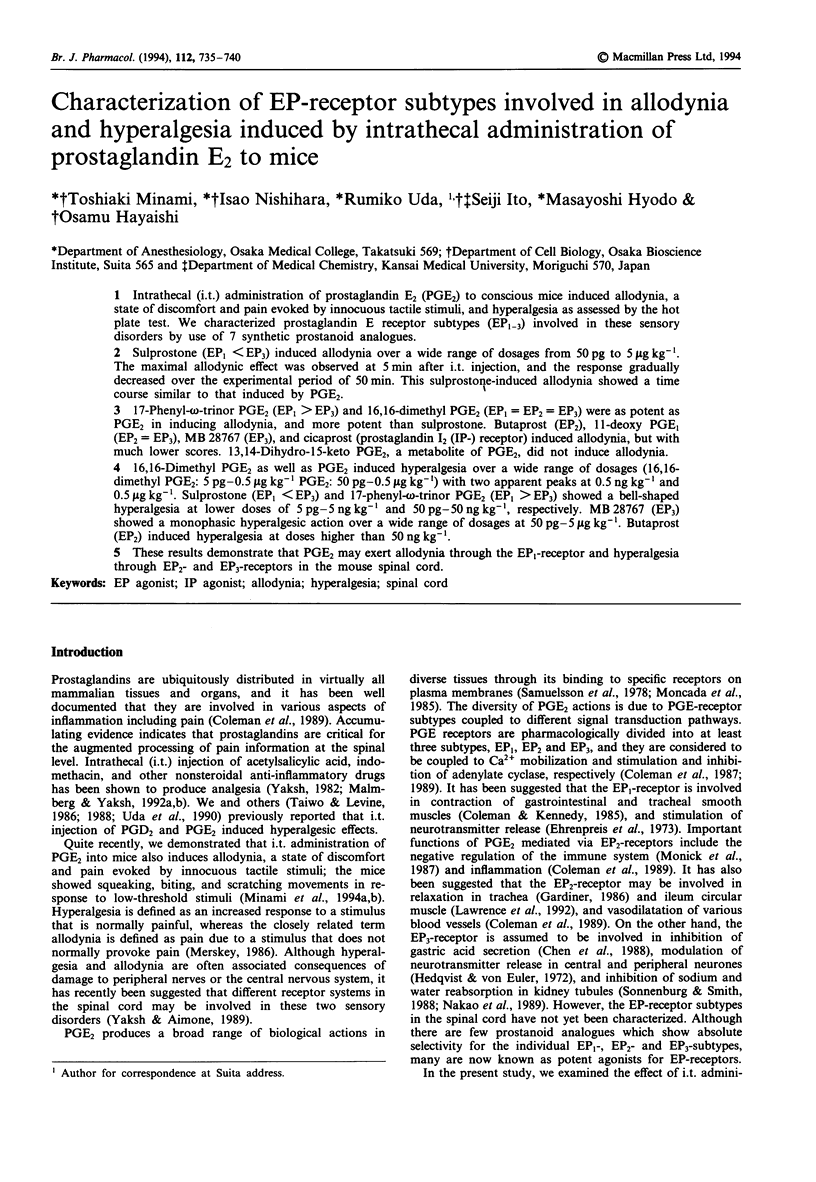
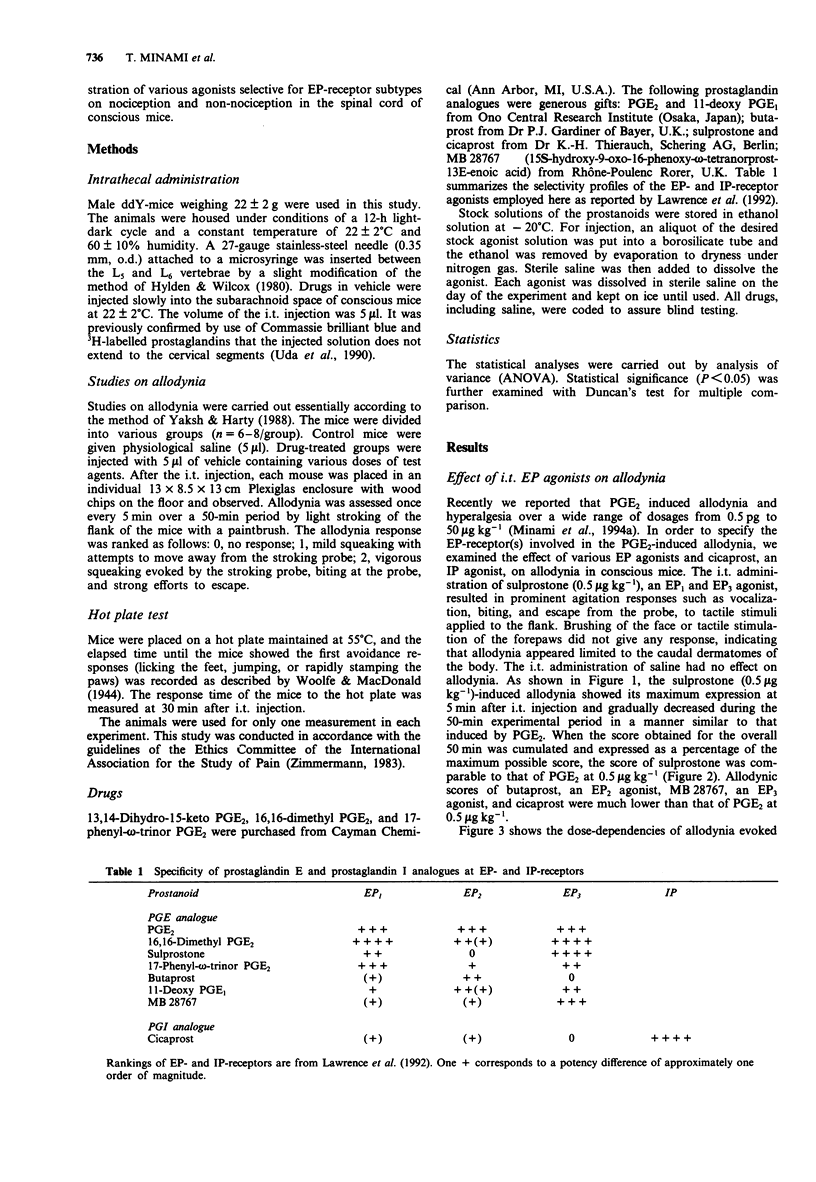
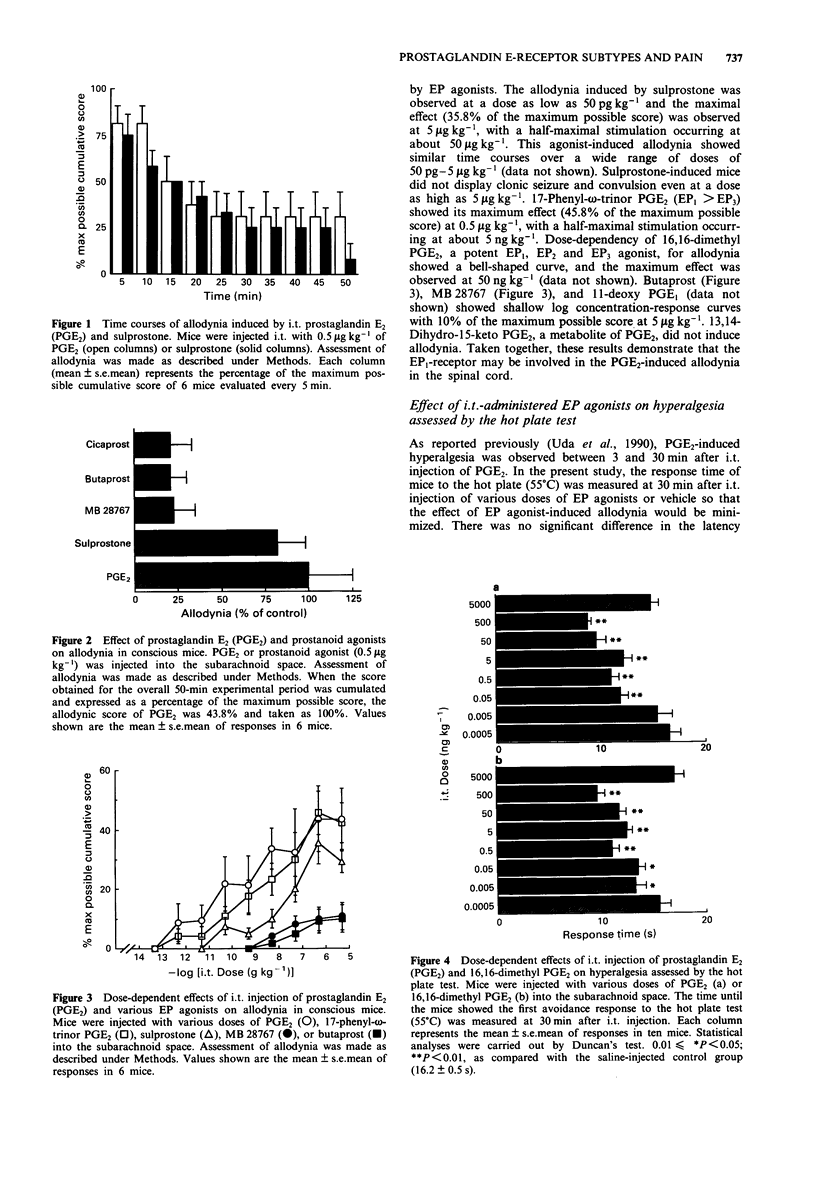
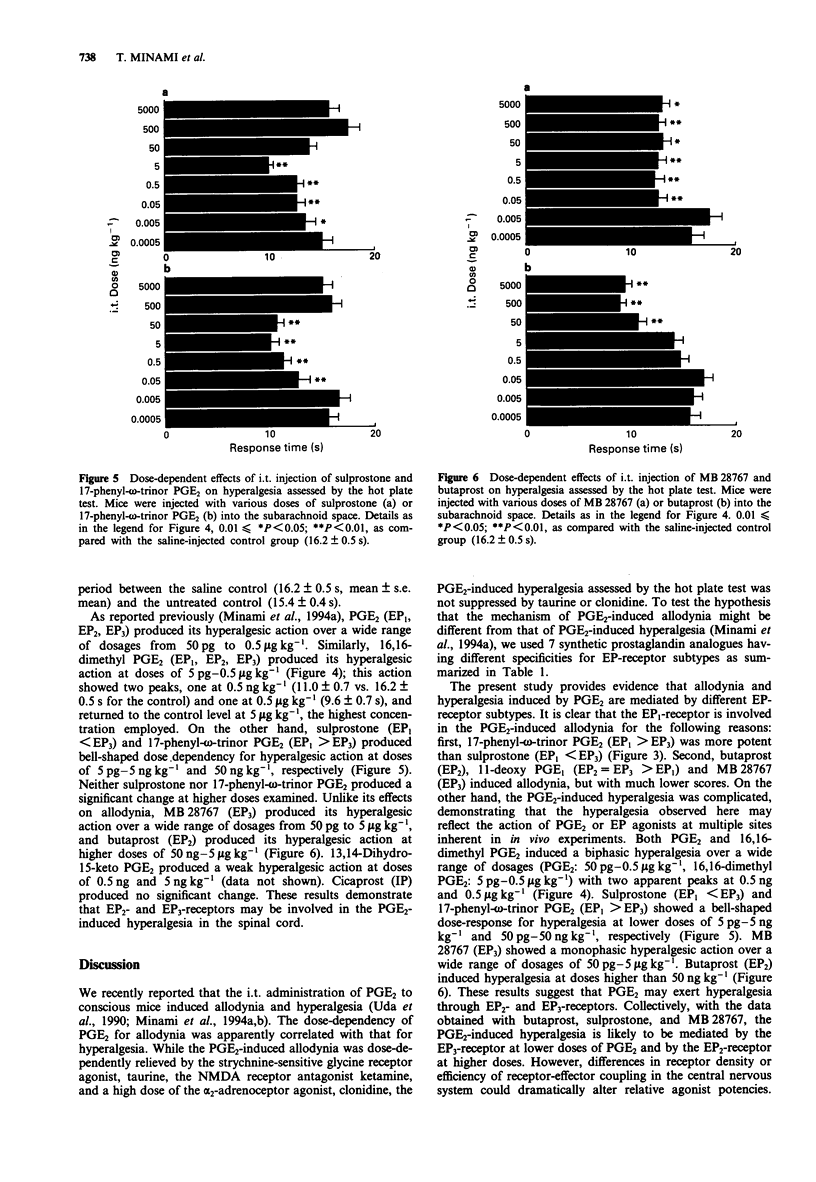
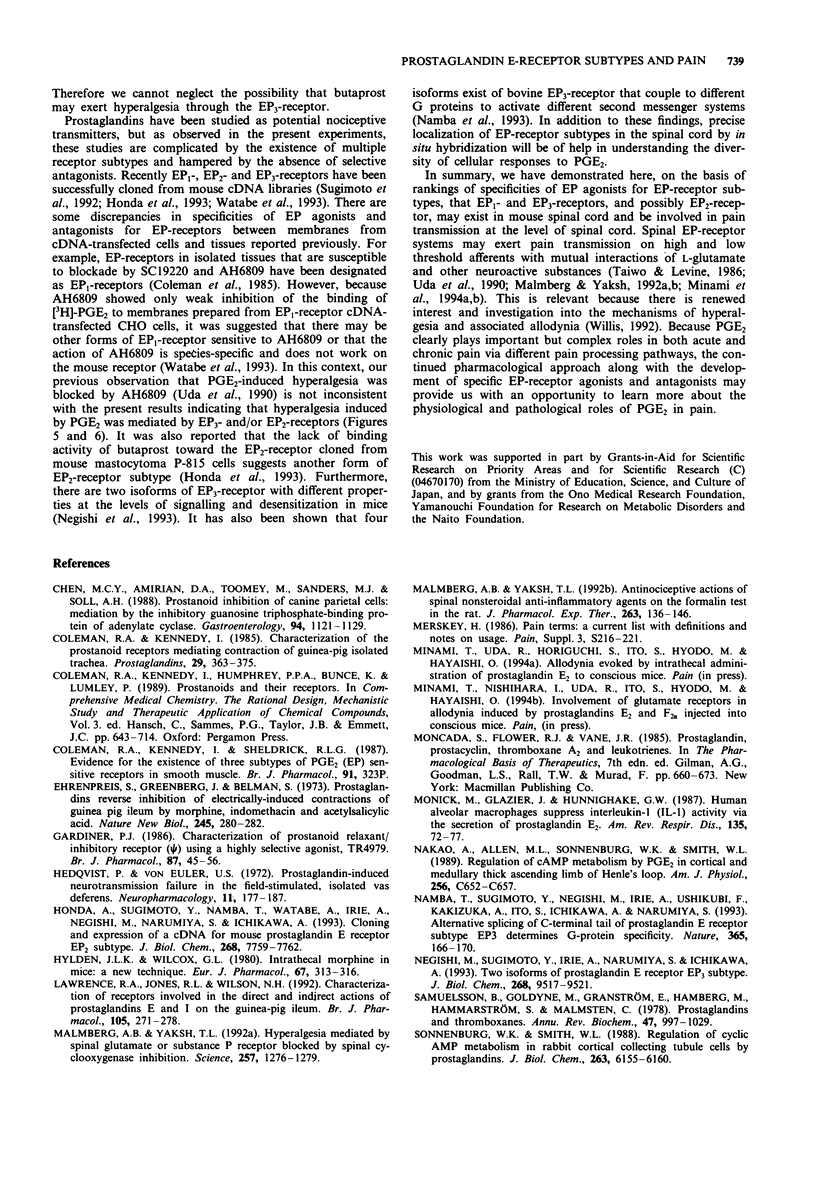
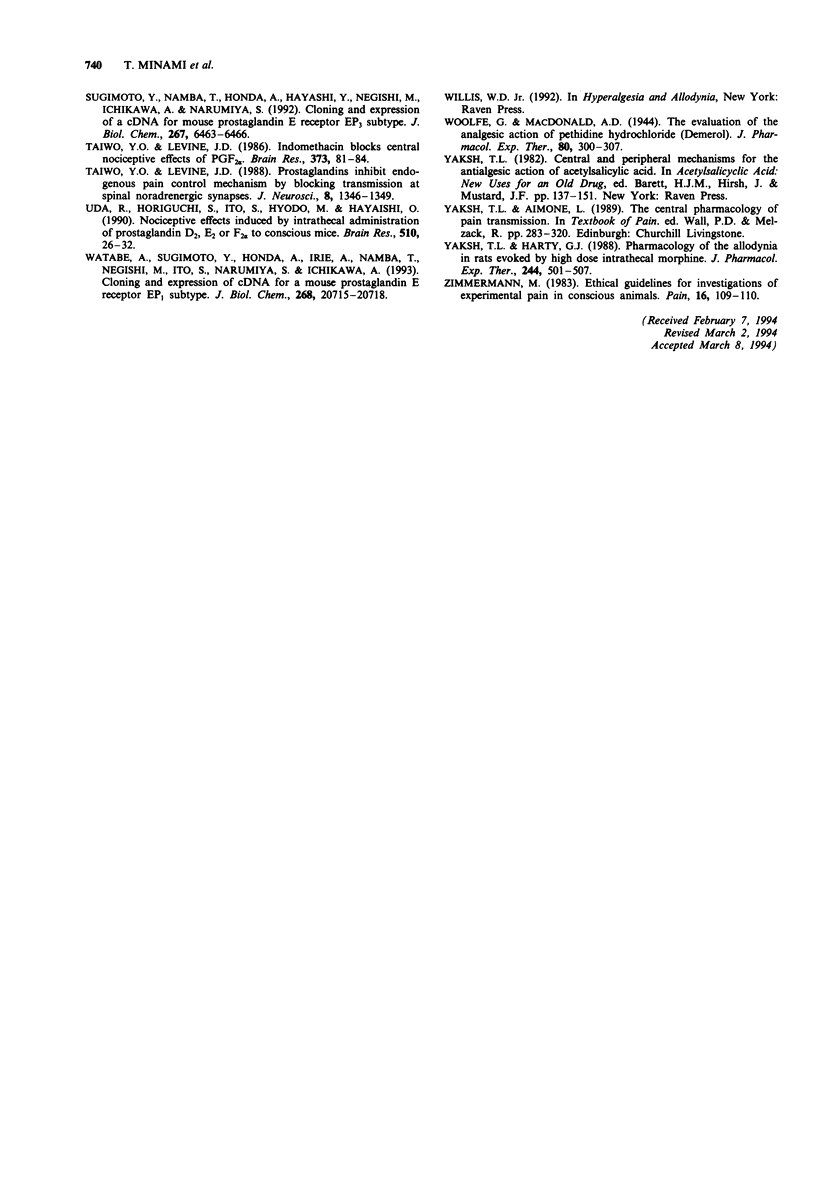
Selected References
These references are in PubMed. This may not be the complete list of references from this article.
- Chen M. C., Amirian D. A., Toomey M., Sanders M. J., Soll A. H. Prostanoid inhibition of canine parietal cells: mediation by the inhibitory guanosine triphosphate-binding protein of adenylate cyclase. Gastroenterology. 1988 May;94(5 Pt 1):1121–1129. doi: 10.1016/0016-5085(88)90002-9. [DOI] [PubMed] [Google Scholar]
- Coleman R. A., Kennedy I. Characterisation of the prostanoid receptors mediating contraction of guinea-pig isolated trachea. Prostaglandins. 1985 Mar;29(3):363–375. doi: 10.1016/0090-6980(85)90096-6. [DOI] [PubMed] [Google Scholar]
- Ehrenpreis S., Greenberg J., Belman S. Prostaglandins reverse inhibition of electrically-induced contractions of guinea pig ileum by morphine, indomethacin and acetylsalicylic acid. Nat New Biol. 1973 Oct 31;245(148):280–282. doi: 10.1038/newbio245280a0. [DOI] [PubMed] [Google Scholar]
- Gardiner P. J. Characterization of prostanoid relaxant/inhibitory receptors (psi) using a highly selective agonist, TR4979. Br J Pharmacol. 1986 Jan;87(1):45–56. doi: 10.1111/j.1476-5381.1986.tb10155.x. [DOI] [PMC free article] [PubMed] [Google Scholar]
- Hedqvist P., Von Euler U. S. Prostaglandin-induced neurotransmission failure in the field-stimulated, isolated vas deferens. Neuropharmacology. 1972 Mar;11(2):177–187. doi: 10.1016/0028-3908(72)90090-1. [DOI] [PubMed] [Google Scholar]
- Honda A., Sugimoto Y., Namba T., Watabe A., Irie A., Negishi M., Narumiya S., Ichikawa A. Cloning and expression of a cDNA for mouse prostaglandin E receptor EP2 subtype. J Biol Chem. 1993 Apr 15;268(11):7759–7762. [PubMed] [Google Scholar]
- Hylden J. L., Wilcox G. L. Intrathecal morphine in mice: a new technique. Eur J Pharmacol. 1980 Oct 17;67(2-3):313–316. doi: 10.1016/0014-2999(80)90515-4. [DOI] [PubMed] [Google Scholar]
- Lawrence R. A., Jones R. L., Wilson N. H. Characterization of receptors involved in the direct and indirect actions of prostaglandins E and I on the guinea-pig ileum. Br J Pharmacol. 1992 Feb;105(2):271–278. doi: 10.1111/j.1476-5381.1992.tb14245.x. [DOI] [PMC free article] [PubMed] [Google Scholar]
- Malmberg A. B., Yaksh T. L. Antinociceptive actions of spinal nonsteroidal anti-inflammatory agents on the formalin test in the rat. J Pharmacol Exp Ther. 1992 Oct;263(1):136–146. [PubMed] [Google Scholar]
- Malmberg A. B., Yaksh T. L. Hyperalgesia mediated by spinal glutamate or substance P receptor blocked by spinal cyclooxygenase inhibition. Science. 1992 Aug 28;257(5074):1276–1279. doi: 10.1126/science.1381521. [DOI] [PubMed] [Google Scholar]
- Monick M., Glazier J., Hunninghake G. W. Human alveolar macrophages suppress interleukin-1 (IL-1) activity via the secretion of prostaglandin E2. Am Rev Respir Dis. 1987 Jan;135(1):72–77. doi: 10.1164/arrd.1987.135.1.72. [DOI] [PubMed] [Google Scholar]
- Nakao A., Allen M. L., Sonnenburg W. K., Smith W. L. Regulation of cAMP metabolism by PGE2 in cortical and medullary thick ascending limb of Henle's loop. Am J Physiol. 1989 Mar;256(3 Pt 1):C652–C657. doi: 10.1152/ajpcell.1989.256.3.C652. [DOI] [PubMed] [Google Scholar]
- Namba T., Sugimoto Y., Negishi M., Irie A., Ushikubi F., Kakizuka A., Ito S., Ichikawa A., Narumiya S. Alternative splicing of C-terminal tail of prostaglandin E receptor subtype EP3 determines G-protein specificity. Nature. 1993 Sep 9;365(6442):166–170. doi: 10.1038/365166a0. [DOI] [PubMed] [Google Scholar]
- Negishi M., Sugimoto Y., Irie A., Narumiya S., Ichikawa A. Two isoforms of prostaglandin E receptor EP3 subtype. Different COOH-terminal domains determine sensitivity to agonist-induced desensitization. J Biol Chem. 1993 May 5;268(13):9517–9521. [PubMed] [Google Scholar]
- Samuelsson B., Goldyne M., Granström E., Hamberg M., Hammarström S., Malmsten C. Prostaglandins and thromboxanes. Annu Rev Biochem. 1978;47:997–1029. doi: 10.1146/annurev.bi.47.070178.005025. [DOI] [PubMed] [Google Scholar]
- Sonnenburg W. K., Smith W. L. Regulation of cyclic AMP metabolism in rabbit cortical collecting tubule cells by prostaglandins. J Biol Chem. 1988 May 5;263(13):6155–6160. [PubMed] [Google Scholar]
- Sugimoto Y., Namba T., Honda A., Hayashi Y., Negishi M., Ichikawa A., Narumiya S. Cloning and expression of a cDNA for mouse prostaglandin E receptor EP3 subtype. J Biol Chem. 1992 Apr 5;267(10):6463–6466. [PubMed] [Google Scholar]
- Taiwo Y. O., Levine J. D. Indomethacin blocks central nociceptive effects of PGF2 alpha. Brain Res. 1986 May 14;373(1-2):81–84. doi: 10.1016/0006-8993(86)90317-3. [DOI] [PubMed] [Google Scholar]
- Taiwo Y. O., Levine J. D. Prostaglandins inhibit endogenous pain control mechanisms by blocking transmission at spinal noradrenergic synapses. J Neurosci. 1988 Apr;8(4):1346–1349. doi: 10.1523/JNEUROSCI.08-04-01346.1988. [DOI] [PMC free article] [PubMed] [Google Scholar]
- Uda R., Horiguchi S., Ito S., Hyodo M., Hayaishi O. Nociceptive effects induced by intrathecal administration of prostaglandin D2, E2, or F2 alpha to conscious mice. Brain Res. 1990 Feb 26;510(1):26–32. doi: 10.1016/0006-8993(90)90723-o. [DOI] [PubMed] [Google Scholar]
- Yaksh T. L., Harty G. J. Pharmacology of the allodynia in rats evoked by high dose intrathecal morphine. J Pharmacol Exp Ther. 1988 Feb;244(2):501–507. [PubMed] [Google Scholar]
- Zimmermann M. Ethical guidelines for investigations of experimental pain in conscious animals. Pain. 1983 Jun;16(2):109–110. doi: 10.1016/0304-3959(83)90201-4. [DOI] [PubMed] [Google Scholar]


